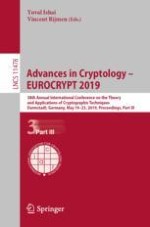2019 | OriginalPaper | Buchkapitel
New Techniques for Obfuscating Conjunctions
verfasst von : James Bartusek, Tancrède Lepoint, Fermi Ma, Mark Zhandry
Erschienen in: Advances in Cryptology – EUROCRYPT 2019
Aktivieren Sie unsere intelligente Suche, um passende Fachinhalte oder Patente zu finden.
Wählen Sie Textabschnitte aus um mit Künstlicher Intelligenz passenden Patente zu finden. powered by
Markieren Sie Textabschnitte, um KI-gestützt weitere passende Inhalte zu finden. powered by
Abstract
-
We abstract the Bishop et al. scheme to obtain an equivalent yet more efficient “dual” scheme that can handle conjunctions over exponential size alphabets. This scheme admits a straightforward proof of generic group security, which we combine with a novel combinatorial argument to obtain distributional VBB security for |S| of any size.
-
If we replace the Reed-Solomon code with a random binary linear code, we can prove security from standard LPN and avoid encoding in a group. This addresses an open problem posed by Bishop et al. to prove security of this simple approach in the standard model.
-
We give a new construction that achieves information theoretic distributional VBB security and weak functionality preservation for \(|S| \ge n - n^\delta \) and \(\delta < 1\). Assuming discrete log and \(\delta < 1/2\), we satisfy a stronger notion of functionality preservation for computationally bounded adversaries while still achieving information theoretic security.
